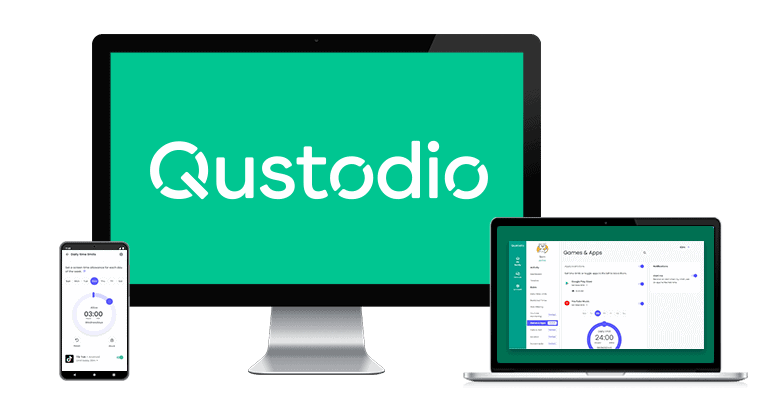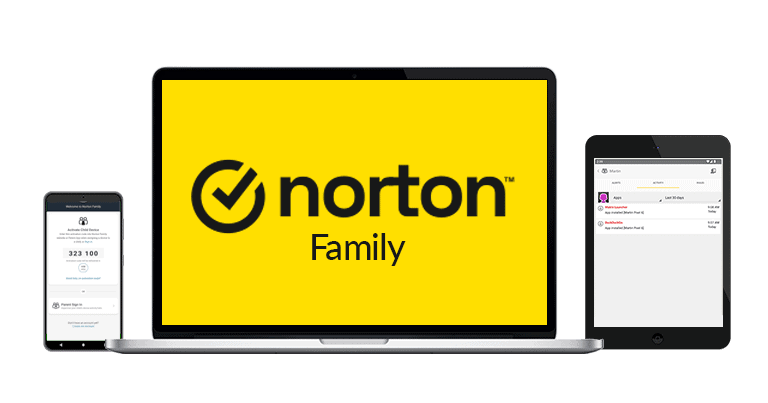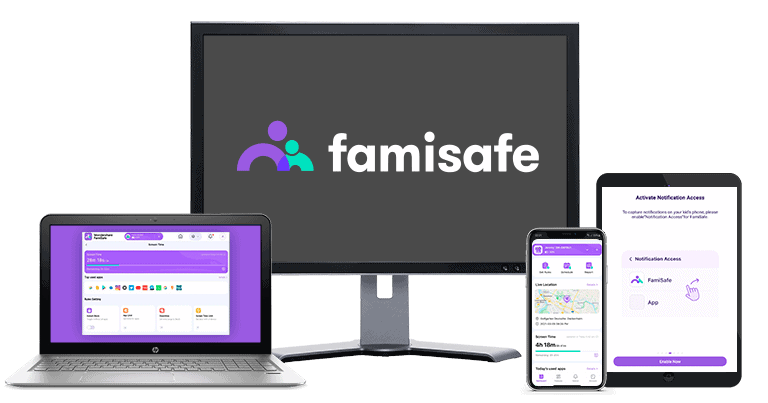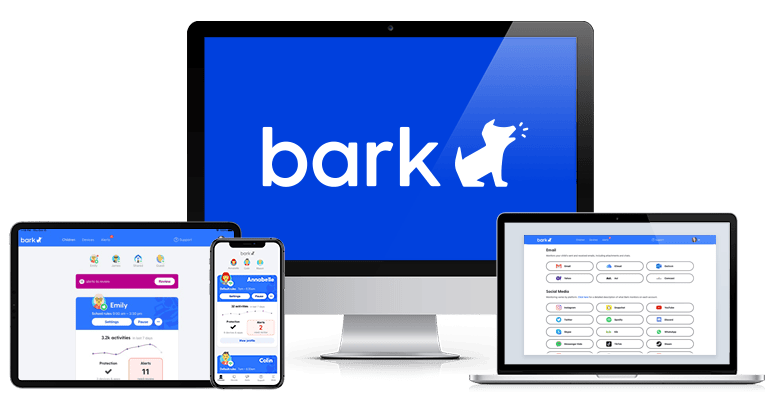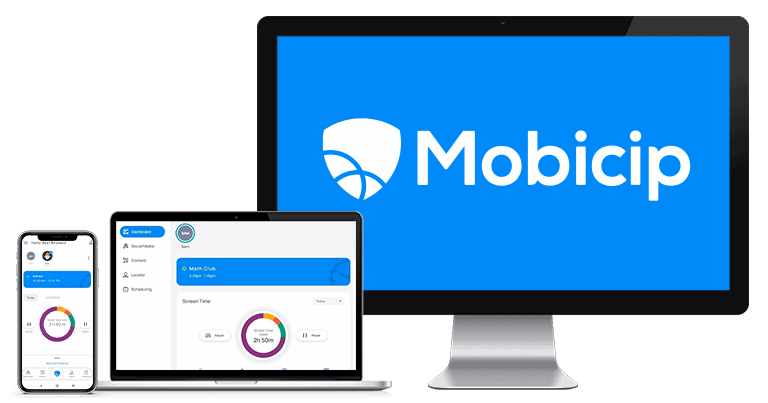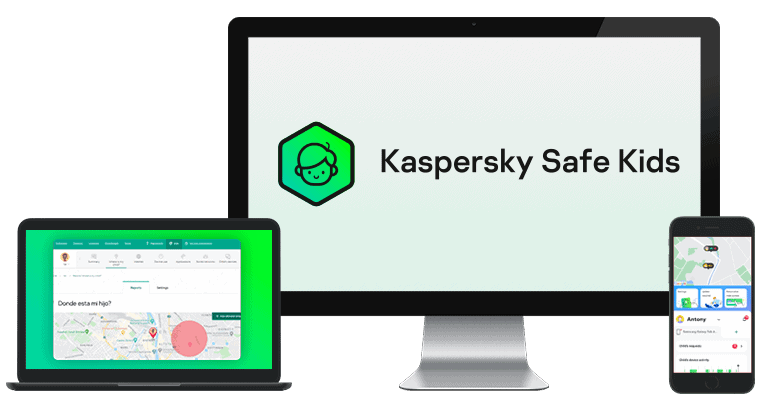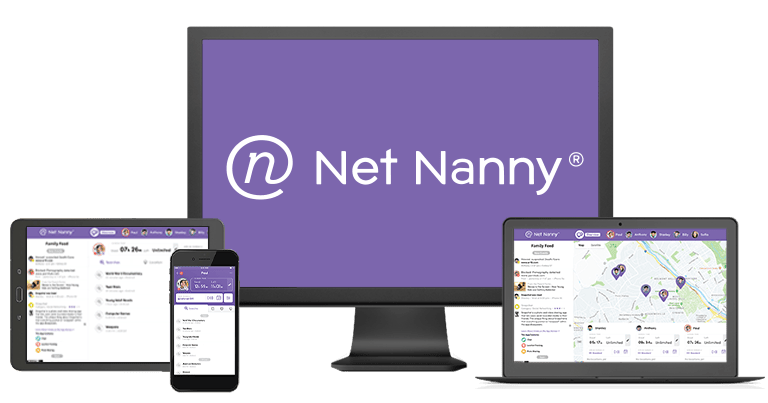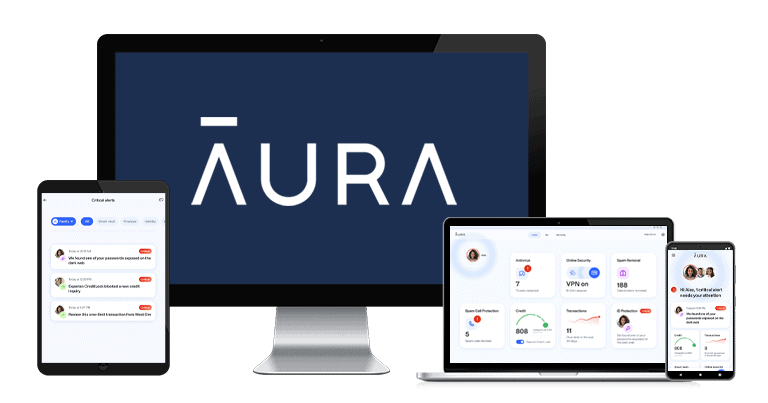
Updated on: April 7, 2024
Short on time? Here’s the best parental control app for Windows in 2024:
- 🥇 Qustodio: Comes with excellent web filtering (not even top VPNs can circumvent it), can detect and block Windows apps that are popular with kids and teens, and has very in-depth activity reports. Also provides access to easy-to-use time limits and scheduling features. Has the best free plan on the market, affordable paid plans, and a 30-day money-back guarantee.
Windows devices are safe for kids, but they can’t protect them from everything. Your children can still accidentally access unsafe, adult sites or use apps that distract them from their chores and homework.
The solution is to use a parental app, but not all of them are great for Windows. I found that many of the apps can’t monitor Windows devices (or do a very poor job of it), are difficult to set up, and/or don’t have beginner-friendly parental apps.
But all of the parental control apps mentioned in this article work really well, allowing you to monitor and restrict your child’s web and app usage on Windows.
My favorite parental control app is Qustodio — it comes with excellent web filtering and monitoring features.
Quick summary of the best parental control apps for Windows:
- 1.🥇 Qustodio — Best parental control app for Windows in 2024 (great web and app filtering features).
- 2.🥈 Norton Family — Useful time limit and scheduling features on an unlimited number of Windows devices.
- 3.🥉 FamiSafe — Flexible app filtering and scheduling on Windows apps popular with kids and teens.
- 4. Bark — Good for non-invasive monitoring of Windows devices and effective web filtering.
- 5. Mobicip — Create an unlimited number of custom web filters for specific times and days.
- Plus 4 more!
🥇 1. Qustodio — Best Parental Control App for Windows in 2024
Qustodio is the best parental control app for Windows in 2024 — it provides excellent monitoring and filtering features that keep your kids safe on the web while helping them to develop healthy digital habits.
Qustodio provides access to the following features on Windows:
- Web filtering. Qustodio blocks access to harmful sites using VPN technology and also comes with 25+ predefined site categories, which is very convenient. You can also block or allow specific websites. I ran multiple tests using top VPNs and none of them were able to bypass Qustodio’s web filtering. In addition, Qustodio has an option that blocks unsupported browsers, so your kids can’t use them to circumvent the app’s web filtering.
- Time limits. Allows you to set daily screen time limits in increments of 15 minutes. When the time is up, you can choose to either lock the navigation (prevent all browsers from using the internet) or lock the device (logs your child out of their account to prevent both online and offline use).
- App filtering. I really like that Qustodio allows you to block access to specific apps or set time limits for them, as this provides more flexibility — for example, you can set time limits for apps like Steam instead of blocking them to provide your kids with some level of online freedom while also making sure they don’t develop screen addiction. Plus, it’s great how Qustodio only displays apps as your kids start using them, as this shows you exactly which apps your kids use the most (and it’s also convenient because you don’t need to go through a long list of irrelevant system apps).
- Scheduling. This lets you set screen time limits for specific periods. For example, you can prevent your kids from using their Windows devices during bedtime.
- Activity reports. Qustodio provides access to daily, weekly, bi-weekly, and monthly activity reports, which show you which restricted sites your kids tried to access, which apps your kids used and for how long they used them, which words your children used the most in their web searches, and more.
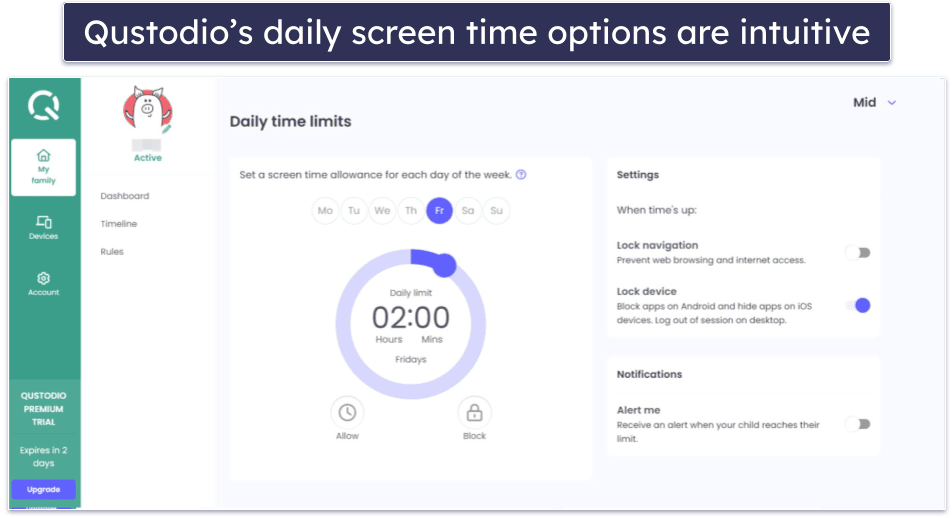
I also like that Qustodio’s kids app for Windows runs quietly in the background, so it won’t bother your child, and you can even hide it so your kid won’t know you installed it on their PC. In addition, the app is lightweight, so it won’t slow down your kid’s PC. Plus, I’m happy that the app comes with uninstall protection, which means your kids can’t manually remove it — they’ll need your parental account credentials to do that.
Qustodio also provides access to a YouTube monitoring feature, which can track your child’s activity on YouTube. It will monitor their YouTube searches and show you detailed information about the videos they watched (including the thumbnail and channel name).
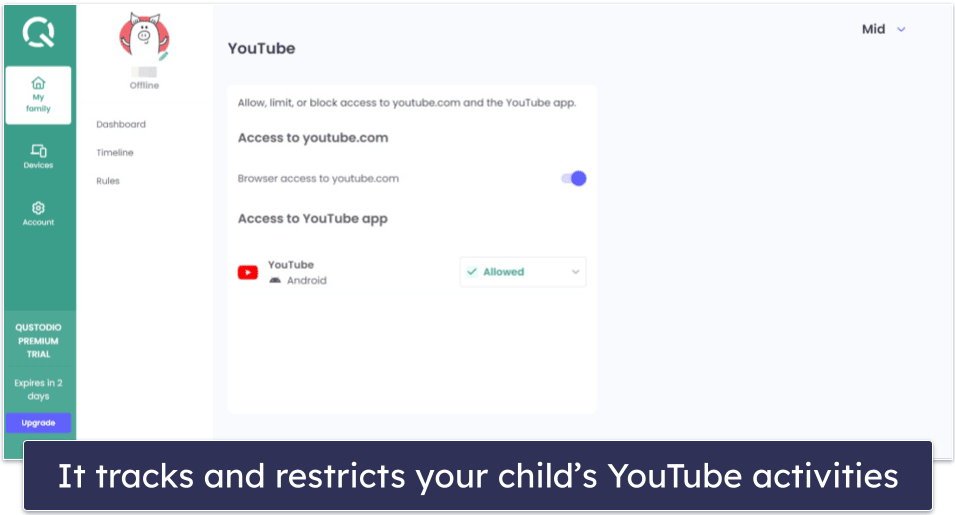
Qustodio comes with the best free plan on the market, as it provides access to web filtering, time limits, and scheduling — but it only lets you monitor 1 device and it limits you to daily and weekly activity reports.
Qustodio’s paid plans start at $54.95 / year. While the pricing is a bit steep, it’s worth it because Qustodio is the best parental app on the market, and it also provides a 30-day money-back guarantee. Depending on your plan, you can monitor 5 or unlimited devices, and get access to app filtering, YouTube monitoring, and bi-weekly or monthly activity reports.
Bottom Line:
Qustodio is the best parental app for Windows in 2024. It provides access to excellent web filtering (which not even top VPNs can bypass), app filtering that saves you time by only displaying the apps your kids use, time limits, scheduling, and in-depth activity reports. It also comes with a really good YouTube monitoring feature and uninstall protection. Qustodio has the best free plan out there, affordable paid plans, and a 30-day money-back guarantee.
Read the full Qustodio review here
🥈 2. Norton Family — Good Windows Parental App for Large Families
Norton Family is an affordable option that allows you to monitor unlimited devices, so it’s a great pick if you have a big family and need to monitor tons of Windows devices. It also provides many good features that allow you to monitor and restrict your child’s web and device usage.
Norton Family provides good web filtering, as it comes with 45+ predefined site categories and even predefined web filtering rules by age. I even tested Norton Family’s web filtering with ExpressVPN, which is the best VPN on the market, and I wasn’t able to circumvent it. That said, I don’t like that Norton Family doesn’t use VPN technology to block inappropriate sites on Windows (like Qustodio does). Norton uses VPN technology on mobile, but on Windows, it only uses browser extensions, which kids can easily disable. Norton Family will alert you if your child does that, though.
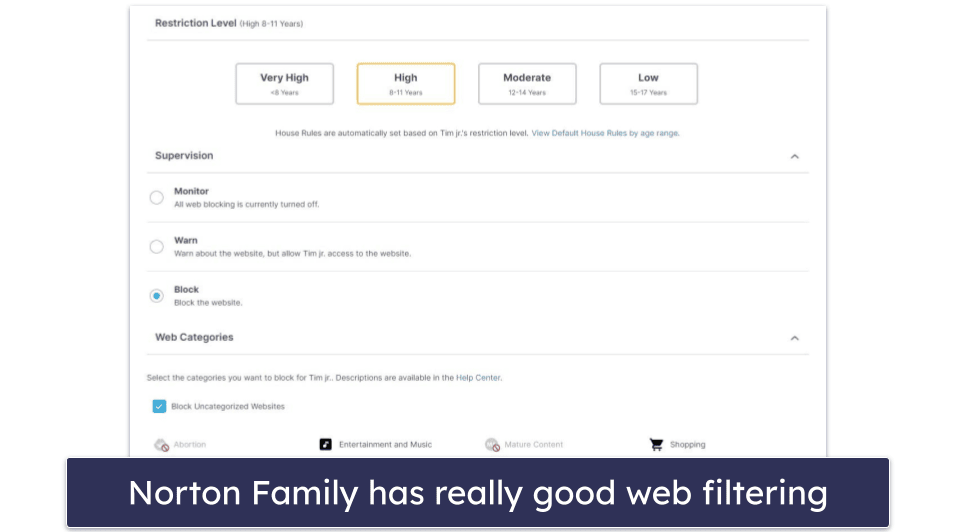
There’s also good app filtering that can detect and block apps like Discord, Steam, GOG Galaxy, and Skype. But Norton Family doesn’t only display the apps your kids use — instead, it displays all the apps installed on your child’s device, so you might need to go through a long list of apps until you find the ones you need to restrict.
Norton Family’s daily time limits and scheduling features are easy to use since you can set time limits using increments of 30 minutes. There are also predefined time limits by age. But I think it’s a shame that Norton Family doesn’t let you set time limits for specific apps (Qustodio does this) — that way, you could reward your child with 2–3 hours of offline games, which is better than whitelisting the games and potentially forgetting to blacklist them when the time is up.
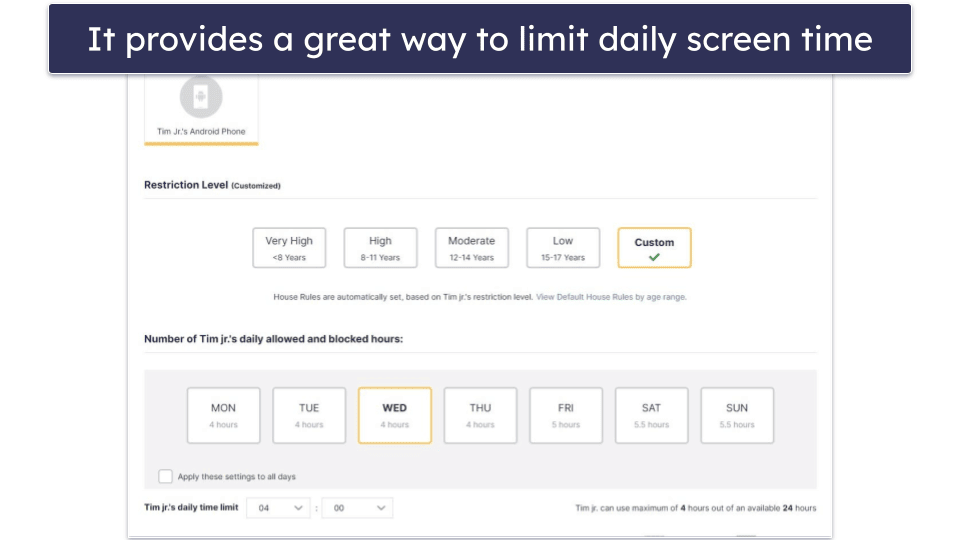
I really like that Norton Family also comes with a School Time feature, which allows you to restrict your child’s web usage during school hours. What’s more, there are features that let you see your kid’s searches on YouTube and search engines like Google, Bing, and Yahoo!. And Norton Family also displays which videos your kids watch on YouTube and Hulu’s sites. I also like that Norton Family’s kids app for Windows runs silently in the background (so it won’t distract your children) and comes with uninstall protection.
Norton Family is available as a standalone subscription, which costs only $49.99 / year. It also comes bundled with the Norton 360 Deluxe ($49.99 / year*) and Norton 360 Advanced ($54.99 / year*) subscriptions — those subscriptions also provide access to Norton 360, which is the best antivirus in 2024. Norton backs all purchases with a 60-day money-back guarantee.
Bottom Line
Norton Family is a great parental control app for large families, as it allows parents to monitor unlimited Windows devices. It comes with great web filtering and app filtering, as well as easy-to-use time limits and scheduling features. In addition, there’s a feature dedicated to school hours and a way to track your kids’ searches and the videos they watch. Norton Family is available as a standalone subscription or bundled with the Norton 360 Deluxe and Norton 360 Advanced subscriptions. It also has a 60-day money-back guarantee.
Read the full Norton Family review here
🥉 3. FamiSafe — Good for Restricting App Usage on Windows
FamiSafe comes with very flexible app filtering options, providing you with many ways to limit your kids’ access to Windows apps. This parental app can detect and block apps that are popular with kids and teens, such as Steam, Skype, Discord, and even torrent clients.
It also allows you to set time limits for apps or schedule specific times when your children are allowed to use certain apps — for example, you can reward your kids with 2 hours of Minecraft for doing their homework, which is much more convenient than whitelisting the game and having to remember to blacklist it after the 2 hours pass.
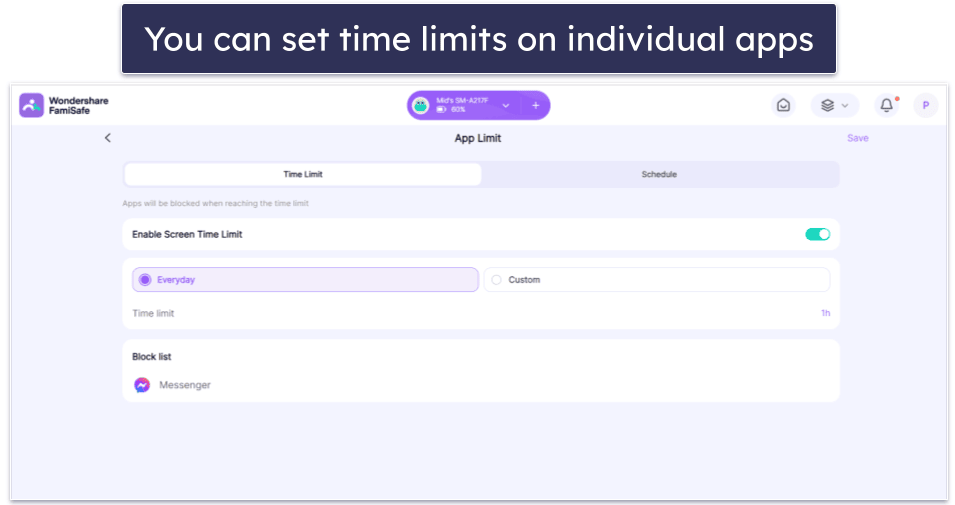
I also like FamiSafe’s downtime feature that prevents your child from using their device past a certain time. This allows you to make sure your kid doesn’t game or spend time on social media when they’re supposed to be sleeping. You can set a downtime for every day of the week or create a downtime schedule for different days of the week. It’s really convenient that you can create different schedules, name them, and just select them when you want to enforce those particular restrictions.
FamiSafe also provides decent web filtering since it comes with 10+ predefined site categories, it can enable safe search, it covers most browsers, and it blocks most adult sites. That said, I don’t think FamiSafe’s web filtering on Windows is as good as Qustodio or Norton Family’s web filtering — Qustodio has 25+ predefined site categories and Norton Family has 45+ categories, so they can block way more inappropriate sites by default (with FamiSafe, you need to manually block many sites to keep your child safe online).
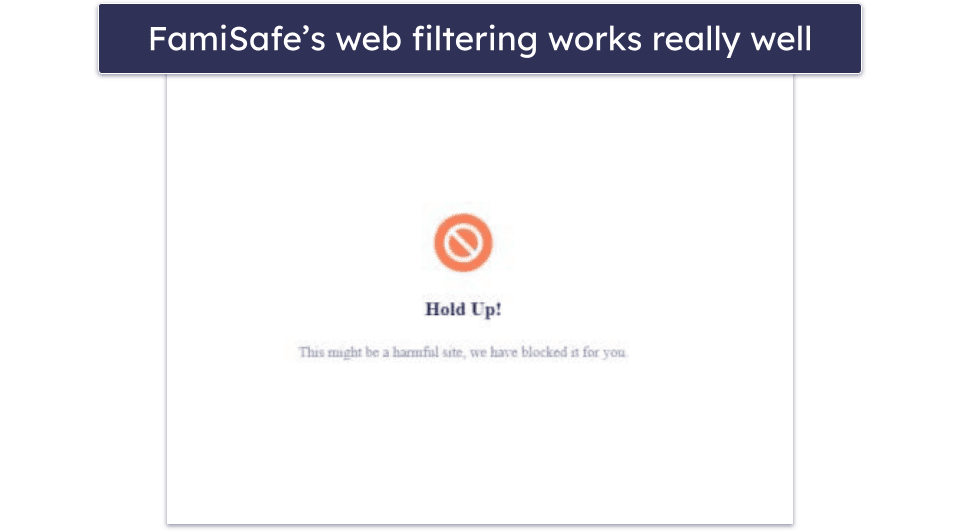
FamiSafe’s paid plans are pretty affordable, as they start at $9.99 / month, and they can monitor between 5 and unlimited devices. FamiSafe backs all of its paid plans with a 7-day money-back guarantee. There’s also a free plan that provides access to all features, but it limits you to 1 device.
Bottom Line
FamiSafe provides very flexible app filtering on Windows — you can choose to block apps, set time limits for them, or schedule specific times when kids can use certain apps. Its web filtering is also pretty decent since it works on most browsers and can block most inappropriate sites. FamiSafe has affordable paid plans and a 7-day money-back guarantee.
Read the full FamiSafe review here
4. Bark — Decent Web Monitoring on Windows Devices
Bark provides pretty in-depth web monitoring on Windows, and it’s also a good pick for large families because it allows you to monitor unlimited devices. On Windows, Bark can monitor stuff like website visits, searches, and incognito browsing on Chrome and Edge, sent and received emails, and image attachments.
However, keep in mind that Bark won’t display everything your kid does on the web — instead, it will scan messages, images, and videos for harmful content and alert you if it detects anything concerning. This includes your kid’s social media accounts like Instagram, Snapchat, YouTube, and Discord. Due to that, I think Bark is more suitable for parents of teens who have a lot of trust in their kids.
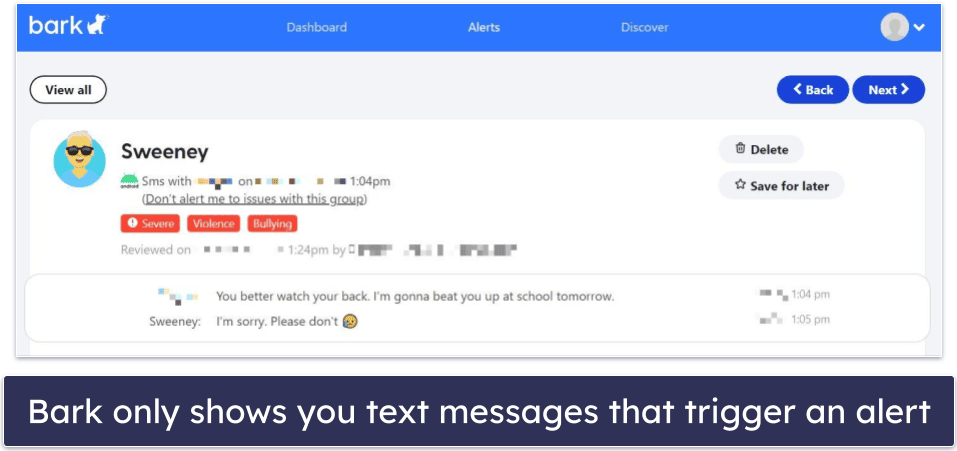
Bark also provides good web filtering — in my tests, it was always able to block my access to adult sites on my Windows device. Bark routes your internet traffic through its VPN to block websites. That said, you’ll need to set up Bark’s browser extension to enforce web filtering rules, which are available for Chrome and Edge. The good news is the extensions are very easy to set up and use.
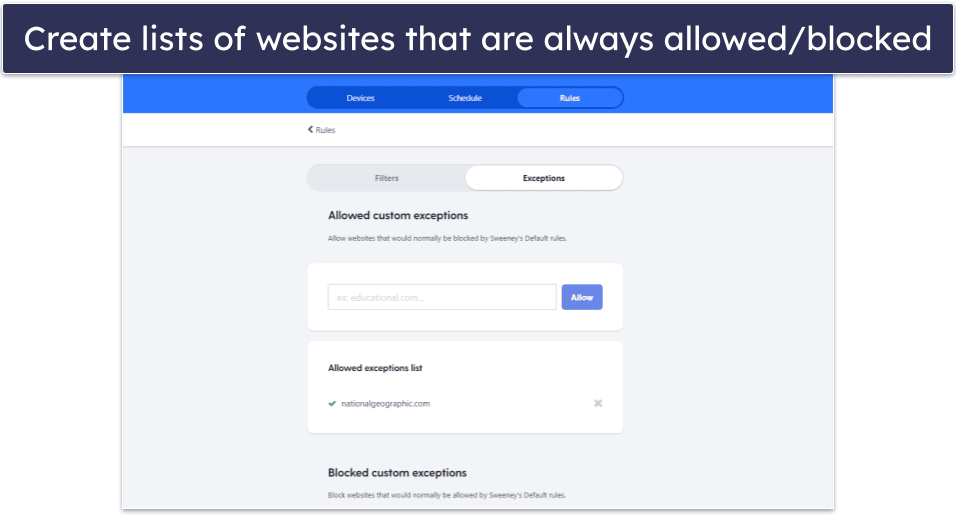
You can also set screen time limits on your kid’s Windows device with Bark but only if you’re willing to get the Bark Home physical device that connects to your Wi-Fi router.
Unfortunately, unlike Qustodio and Norton Family, Bark can’t block access to Windows apps (so I only recommend using it for web monitoring and filtering).
Bark provides regular activity reports, but they’re very basic and you don’t get as much information as you do with Qustodio activity reports. You can see the types of activities that were blocked or allowed and any information that triggered an alert.
Bark comes with 2 tier-based subscriptions — Bark Jr. ($49.00 / year) provides access to screen time management, web filtering, and location tracking, and Bark Premium ($14.00 / month) adds access to all features. Unlike the other parental apps on this list, Bark doesn’t come with a money-back guarantee.
Bottom Line
Bark provides tons of information about your child’s web browsing on Windows — like what they search for, which sites they access, and what emails they send or receive. But instead of showing you everything your kid does online, it only alerts you if it detects concerning content. It also allows you to monitor unlimited devices and provides decent web filtering. Bark comes with 2 tier-based subscriptions and doesn’t have a money-back guarantee.
Read the full Bark review here
5. Mobicip — Customizable Web Filters for Windows
Mobicip offers a lot of customizability when it comes to scheduling your children’s device usage on Windows. The app lets you create an unlimited number of custom web filters for specific times and days, which is great if you want to make sure that your kid isn’t accessing certain websites when it’s past their bedtime.
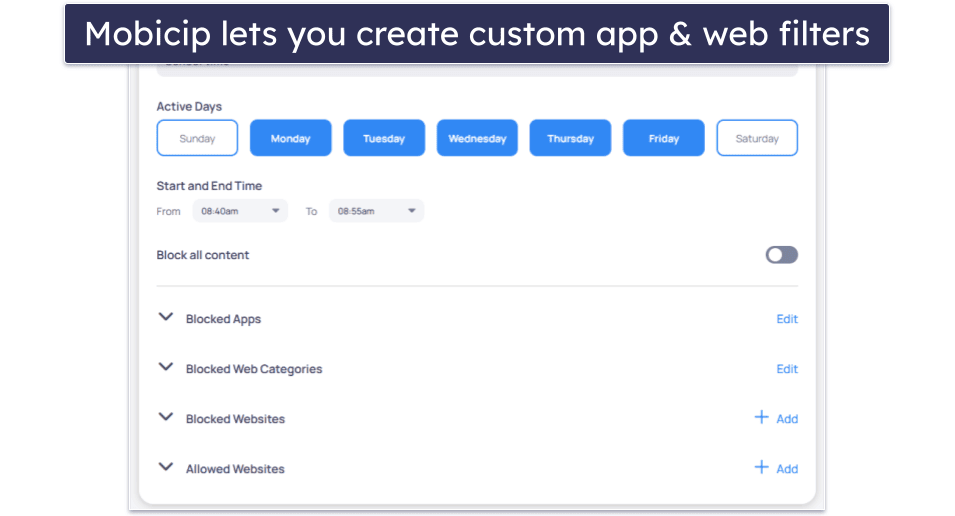
Mobicip’s web filtering allows you to manage access to websites in 15+ predefined categories, but its list is not as extensive as competitors like Qustodio (which has 25+ predefined categories) and Norton Family (which has 45+ categories). The good news is you can create additional filters with specified keywords, and your child can always request access to blocked websites directly within the app, which, if approved, adds the site to a whitelist for future access.
Mobicip also filters inappropriate YouTube searches through a browser (it filters keywords, phrases, and on-page content in real-time) and makes sure that the “Restricted Mode” is on at all times. I still prefer Qustodio’s dedicated YouTube feature that also shows you what videos your kid watches on the platform.
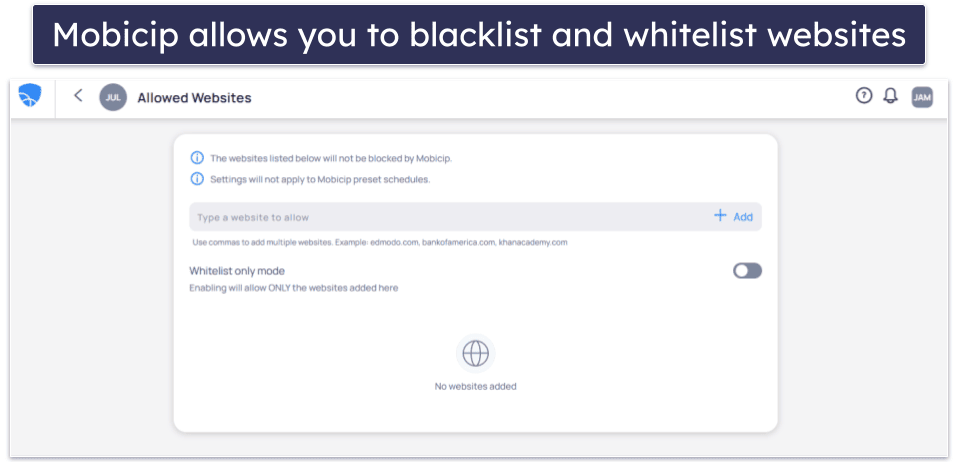
Mobicip offers 3 annual plans, with the Lite ($2.99 / month) and Standard ($4.99 / month) plans covering up to 5 and 10 devices, respectively. The Premium plan ($7.99 / month) grants access to additional features, like setting time limits on app categories, and supports up to 20 devices. All of its plans come with a 7-day free trial and are backed by a 30-day money-back guarantee. There’s also a free Basic plan with limited features and coverage for only 1 device.
Bottom Line:
Mobicip offers highly customizable scheduling and web filtering features for Windows. I think its Vacation Mode and grace time request options are very convenient, and I like that it offers keyword filtering. Mobicop also has decent search filtering for YouTube and includes uninstall protection on Windows. It offers affordable plans, has a 7-day free trial, and backs each plan with a 30-day money-back guarantee.
6. McAfee Safe Family — Great For Setting Time Limits on Windows
McAfee Safe Family lets you schedule when and how long your kid can use their Windows device. You can schedule screen time limits in 30-minute increments for specific weekdays. This gives you excellent flexibility, so your kid can get more screen time during the weekend and make sure they don’t spend too much time in front of their PC on school days.
McAfee’s app filtering is really good, too. You’ll see every app on your kid’s Windows device on your McAfee dashboard. From here, you can allow and block specific apps and set daily time limits for them in 30-minute increments.
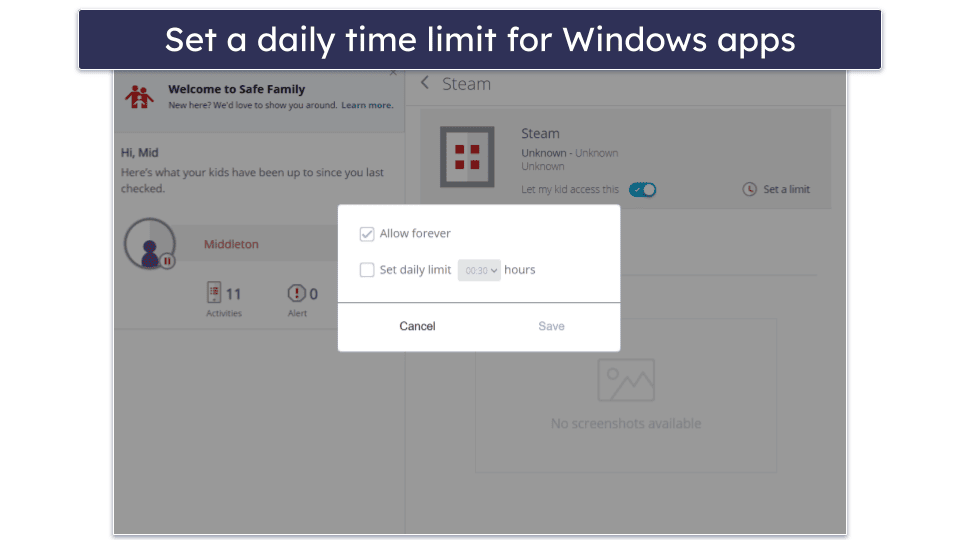
I like its web filtering, too. McAfee automatically blocks inappropriate sites based on your kid’s age. For example, a 12-year-old won’t be able to access dating and gambling sites but will have access to games and entertainment content. In tests, these filters worked in incognito mode and even when I used a VPN. I still prefer Norton Family, as it filters content by 45+ content categories, compared to McAfee’s 15+ website categories.
I think it’s great that McAffe allows your kid to request access to a site. This makes sure your kid always has access to necessary educational resources that might have been inaccurately blocked.
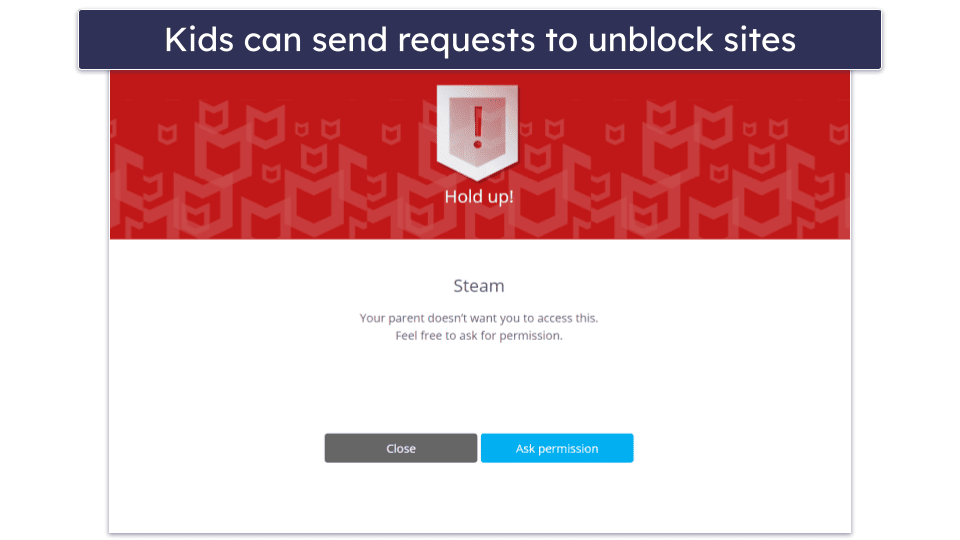
McAfee’s activity reports are simple. They show you which apps and sites your child has visited (or attempted to access) and when, but that’s about it. Qustodio‘s activity reports are more comprehensive, as you get a snapshot of how your child uses their device daily, weekly, or monthly.
McAfee Safe Family costs $7.99 / month, with options to bundle it with McAfee+ Premium ($49.99 / year), McAfee+ Advanced ($79.99 / year), and McAfee+ Ultimate ($179.99 / year). I recommend getting the McAfee+ Ultimate package, as it includes excellent antivirus software, a VPN, and identity theft protection, so you get a comprehensive solution that protects you from all kinds of online threats.
Bottom Line:
McAfee Safe Family is a great choice for setting time limits on your kid’s Windows PC. It lets you set custom schedules, which gives you a lot of flexibility, and you can even set daily time limits for every app your kid has on his PC. McAfee’s web filtering works well, and your kid even gets an option to request access to a blocked site in case the filters accidentally blocked a site they need for school or extracurricular activities. All McAfee plans come with a 30-day money-back guarantee.
Read our full McAfee Safe Family review
7. Kaspersky Safe Kids — Good YouTube Search Monitoring on Windows
Kaspersky Safe Kids lets you monitor and restrict your child’s YouTube searches on Windows. The app allows you to see what your kids search on YouTube’s site and gives you access to their YouTube search history for 30 days. You can turn on YouTube Safe Search to block all inappropriate searches and prevent your children from accessing inappropriate content.
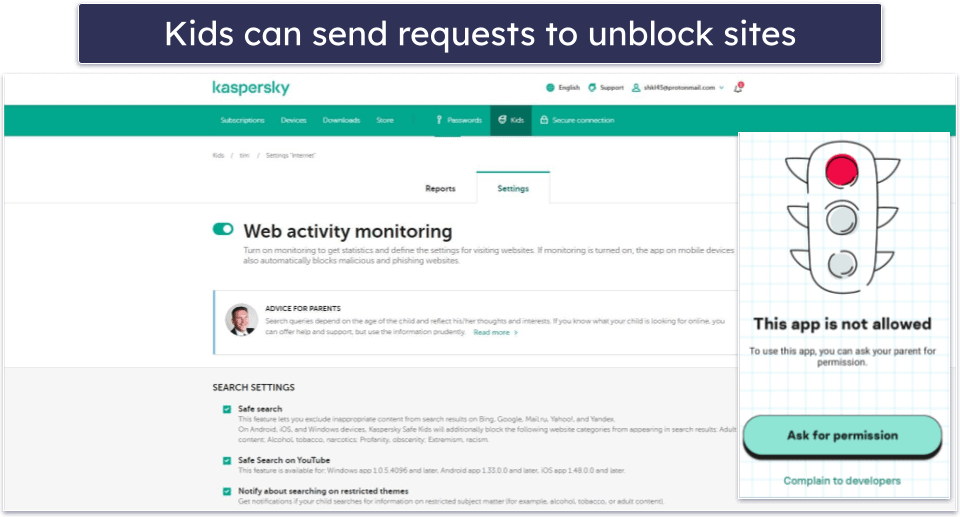
Kaspersky Safe Kids has great web filtering and includes 10+ predefined site categories for blocking or whitelisting websites. Competitors like Qustodio and Norton Family offer more categories, but I really like that Kaspersky’s kids’ app allows children to request access to blocked sites within the app. Plus, it always blocked all websites in my tests.
I’m also really happy to see that VPNs can’t bypass their web filtering. I tested the kids’ app with several top VPNs, and they weren’t able to get around the web filters I set in the parents’ app.
Kaspersky Safe Kids provides flexible options for setting time limits and scheduling, with the ability to block devices or simply send warnings when daily time limits are reached. It’s easy to set daily screen time limits, and the app allows you to choose which apps can still be used when the device is blocked.
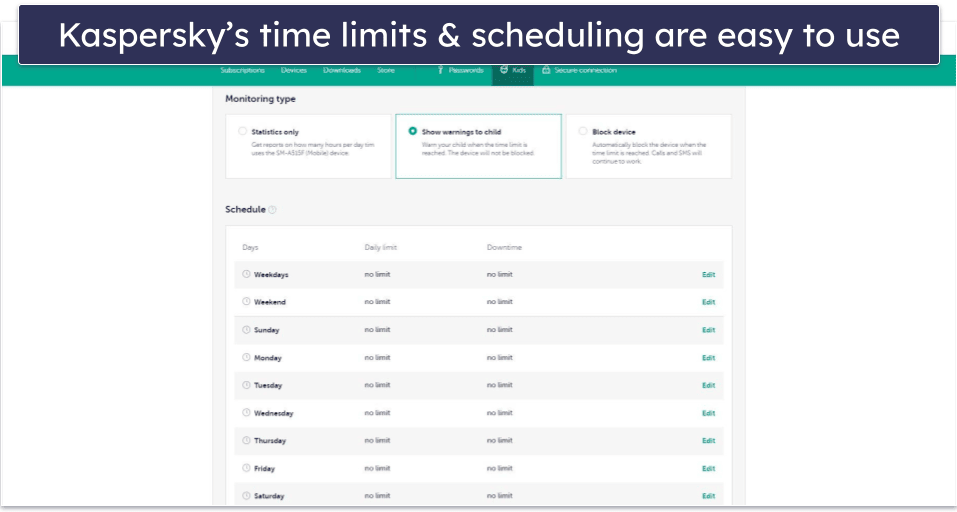
Bottom Line:
Kaspersky Safe Kids provides a great YouTube Safe Search feature and very good web filtering with 10+ predefined site categories on Windows. I like that the app lets kids request access to specific blocked sites, and I was impressed to see that not even the top VPNs can bypass its web filtering. Kaspersky Safe Kids supports unlimited devices and comes with a 30-day money-back guarantee.
Read our full Kaspersky Safe Kids review
8. Net Nanny — Great Choice for Web Filtering on Windows
Net Nanny provides good web filtering as well as other helpful web and screen time monitoring features. I really like that Net Nanny’s web filtering uses a VPN, making it harder for kids to bypass restrictions.
However, Net Nanny only has 10+ predefined categories, which is fewer than Qustodio’s 25+ categories and Norton Family’s 45+ categories, but you can create custom filters and add keywords you want blocked on your kid’s Windows device.
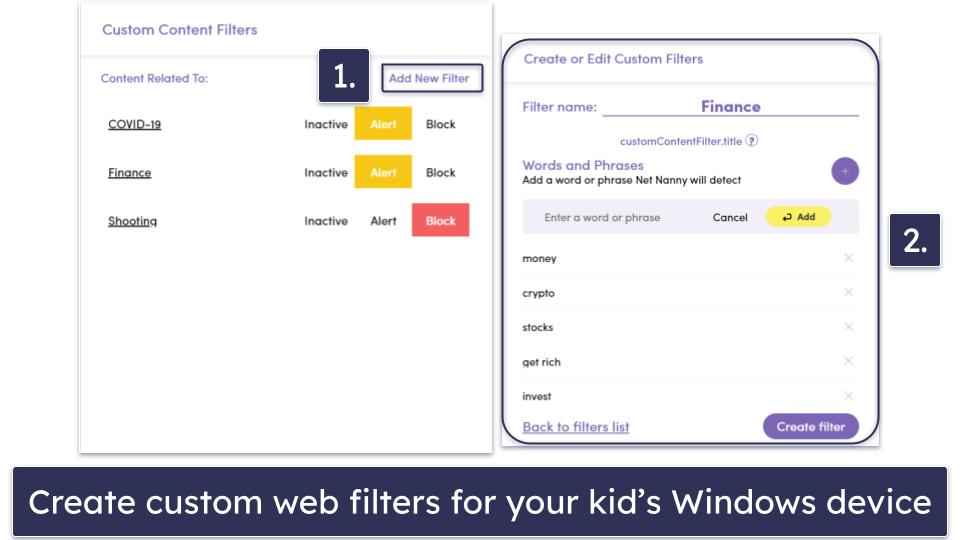
That said, Net Nanny has an option to mask profanity on websites — it replaces all profane words with “######.” I tested this by visiting 10+ web pages that contained swear words, and Net Nanny always censored them.
Unfortunately, Net Nanny can’t detect and block Windows apps (like Qustodio and Norton Family), so you can’t use it to prevent your kids from playing offline games.
On the plus side, Net Nanny has a daily time limit feature, which lets you set limits in increments of 15 minutes. Whenever I reached these limits in my tests, Net Nanny overlaid the screen with a message that said I was out of screen time. I couldn’t open any app without the pop-up showing up on my screen (except for the messaging app). It works well, but it’s a shame Net Nanny doesn’t let you set time limits for apps like Qustodio does.
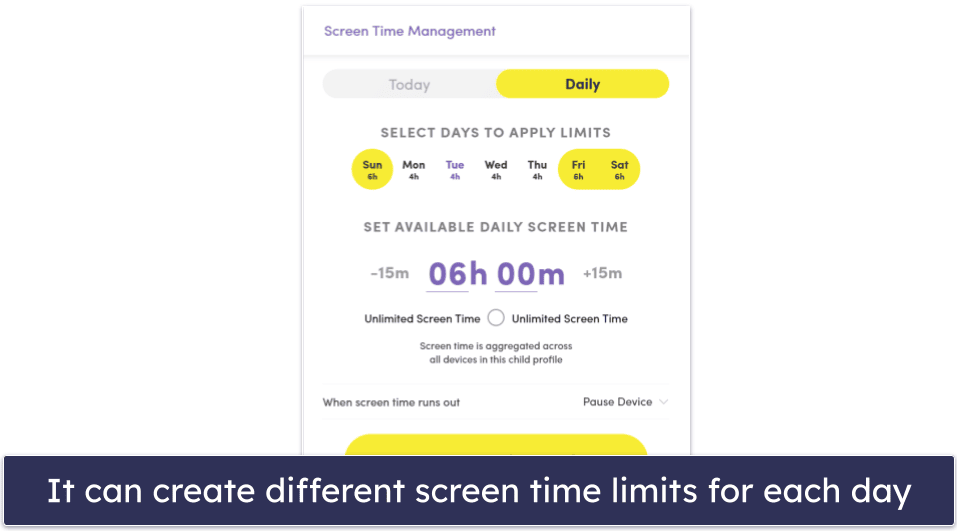
Net Nanny also lets you schedule downtime and curfews, provides activity reports, and has a dedicated YouTube monitoring feature that shows you what your kid is watching and how long they watched each video.
Net Nanny has 3 paid subscriptions, which all provide access to the same features but monitor a different number of devices. The basic subscription ($39.99 / year) covers 1 Windows device, and the Family Protection Pass subscriptions cover 5 devices ($54.99 / year) and 20 devices ($89.99 / year). Net Nanny plans come with a 14-day money-back guarantee.
Bottom Line
Net Nanny provides good web filtering on Windows and can censor profane words. It also provides time limits, scheduling, activity reports, and a dedicated YouTube monitoring feature. Net Nanny has 3 paid subscriptions and a 14-day money-back guarantee.
Read the full Net Nanny review here
9. Aura — Good for Keeping Your Kids Safe While Gaming (US Only)
Aura’s Windows app is great for protecting your kids from cyberbullying and predators while playing online video games via its Safe Gaming feature.
This covers 200 popular online games, including Minecraft, Roblox, Fortnite, Call of Duty, and more. It works by looking at your kid’s text and voice chats for cyberbullying language or sexual behavior and alerts you when it detects problematic language. In my tests, it accurately alerted me about inappropriate language in my Call of Duty chats.
I like how the app is user-friendly — all you need to do is install it on your kid’s Windows PC and let it work in the background. Aura automatically starts monitoring all of your children’s gaming chats, so you don’t have to manually set up any rules.
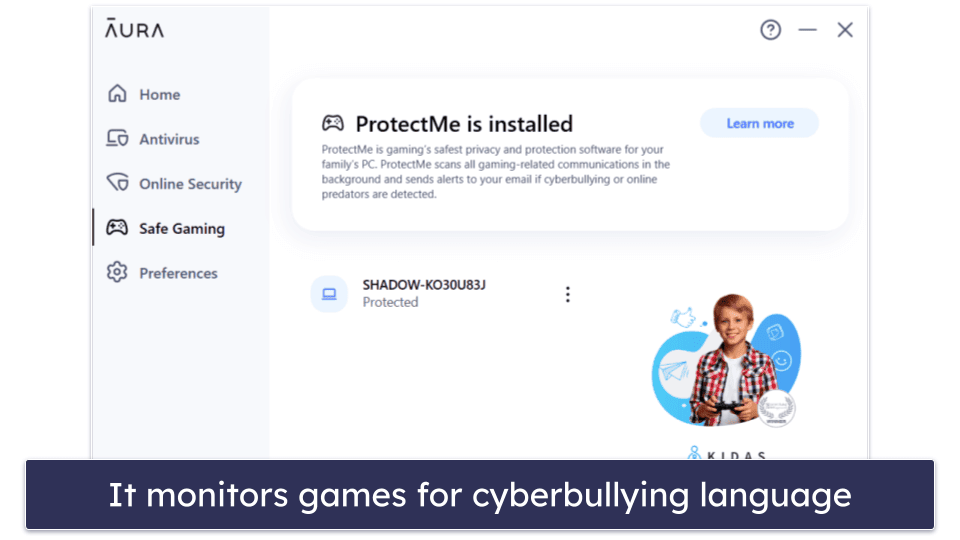
Unfortunately, Aura’s Windows app doesn’t come with any other forms of parental controls. You can’t set time limits, monitor or restrict web and app activity, or pause the internet on your kid’s Windows PC. For that I recommend Qustodio or Norton Family, as they give you a lot of granular control over your kid’s activities on Windows.
Aura’s parental controls are priced at $32.00 / month and are included in the Family plan along with antivirus and VPN services, backed by a 60-day money-back guarantee. While these controls aren’t available for individual purchase, bundling them together provides greater value. The plan covers 10 devices per adult for as many as 5 adults, with the flexibility to monitor an unlimited number of devices.
Bottom Line:
Aura’s Safe Gaming feature is great for protecting kids from cyberbullying in games on Windows. It monitors both text and voice chats in 200+ games and it does that automatically, so all you have to do is install it on your kid’s device. Aura is only available as part of the Family plan, which comes with a VPN, an antivirus, and a 60-day money-back guarantee.
Comparison of the Best Parental Control Apps for Windows in 2024
How to Choose the Best Parental Control App for Windows in 2024
- Choose a parental app which lets you supervise Windows devices. It ought to have a specific children’s app for Windows or a browser extension that allows you to observe your child’s activities on their device and manage their usage.
- Find a parental control app with industry-standard features. It should have key features for Windows, like web and app filters, time restrictions, and activity reports.
- Pick a service that provides good performance. The parental control app’s features should work without any issues — for example, VPNs shouldn’t be able to bypass its web filtering, and its app filtering needs to be able to block Windows apps that are popular with kids and teens like Discord, Steam, and Netflix. Also, the provider’s kids apps should be lightweight, so that they don’t consume too many resources (which can slow down your child’s PC).
- Go for a parental control app that’s easy to use. All of the apps I recommend have clear interfaces, making it simple for parents (even those less tech-savvy) to navigate. Setting up the child app on a Windows device for your young one is also a quick process.
- Pick a parental app that provides good value. Some of the parental apps in this article also provide access to additional features, such as YouTube monitoring and uninstall protection (like Qustodio and Norton Family). What’s more, all of my top picks have affordable plans and come with free plans, free trials, or generous money-back guarantees, so that you can test their services risk free.
Top Brands That Didn’t Make the Cut
- Microsoft’s Family Safety. This parental app comes with many features, including web and app filtering, time limits, and activity reports. That said, its apps are glitchy and often display errors, and some of its features don’t work — for example, its time limits often don’t disable access to kids’ devices. Plus, Family Safety can only block sites on Edge, so your kids can use other browsers to bypass the filtering (unless you use Family Safety’s app filtering, which is inconvenient to use on Windows).
- KidLogger. KidLogger shows you how much time your kids spend on the PC, monitors web and app usage, and can block sites. But it also takes screenshots of your child’s screen, which I honestly think is too invasive and will only damage your relationship with your kids instead of improving it. Plus, KidLogger can’t block Windows apps, doesn’t let you set time limits, and its parental apps are not user-friendly.
- OpenDNS. This parental control service is free to use, but it can only filter inappropriate websites. So, you can’t use it to set time limits, block apps, or monitor your child’s YouTube activity. What’s more, OpenDNS doesn’t have a kids app for Windows — instead, you need to manually set it up on your router, which is time-consuming and inconvenient.
Frequently Asked Questions
What is the best parental control app for Windows?
I think Qustodio is the best parental app for Windows in 2024 — it provides excellent web filtering (not even top VPNs can bypass it), really good app filtering, time limits and scheduling, in-depth activity reports, and a dedicated YouTube monitoring feature.
Are there free parental control apps for Windows?
I don’t normally recommend using free parental apps because they’re either dangerous to use (since you give them tons of permissions to access sensitive data) or they lack essential parental control features. That said, if you insist on using a free parental app for Windows, I’d go with Qustodio’s free plan, as it’s the best on the market — it comes with web filtering, time limits and scheduling, and daily and weekly activity reports, but it only allows you to monitor 1 Windows device.
But, overall, I only recommend using a free parental control app to test the service to see if it’s right for you — you get significantly better value by upgrading to a premium paid parental app, like one of Qustodio’s paid plans.
Can’t I just use built-in parental controls on Windows?
Windows comes with built-in parental controls called Family Safety, but I don’t recommend using it — while it has many features, most of them don’t work well. What’s more, web filtering only works on Edge, so your kids can use unsupported browsers to access inappropriate sites (you can block them using the app filtering feature, but it’s time-consuming because it’s not user-friendly).
I honestly think you’re much better off using a premium parental app like Qustodio — it provides excellent web and app filtering on Windows, and also comes with time limits, scheduling, in-depth activity reports, and even a dedicated YouTube monitoring feature.
Can I monitor my child’s PC from my Android or iOS device?
Yes, as most parental services have apps for parents that run on Android and iOS devices — for example, Qustodio has parental apps for iOS and Android that are very intuitive, so you’ll have an easy time getting used to them even if you’re not tech-savvy.
